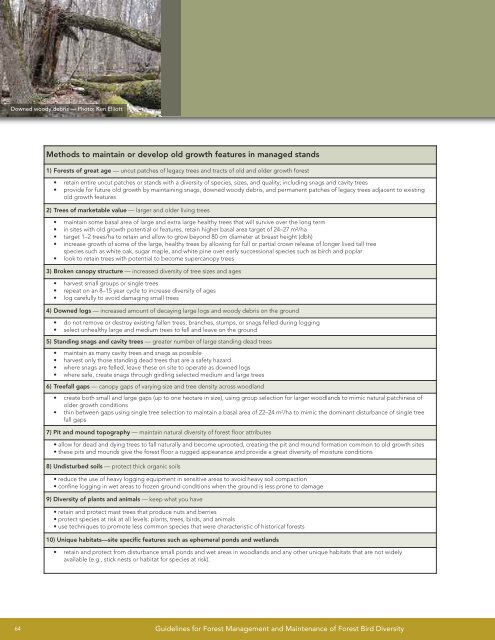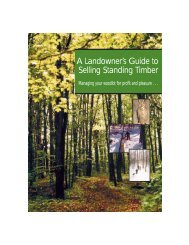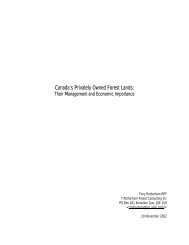A land manager's guide to conserving habitat for forest birds in ...
A land manager's guide to conserving habitat for forest birds in ...
A land manager's guide to conserving habitat for forest birds in ...
Create successful ePaper yourself
Turn your PDF publications into a flip-book with our unique Google optimized e-Paper software.
Downed woody debris — Pho<strong>to</strong>: Ken Elliott<br />
Methods <strong>to</strong> ma<strong>in</strong>ta<strong>in</strong> or develop old growth features <strong>in</strong> managed stands<br />
1) Forests of great age — uncut patches of legacy trees and tracts of old and older growth <strong>for</strong>est<br />
• reta<strong>in</strong> entire uncut patches or stands with a diversity of species, sizes, and quality; <strong>in</strong>clud<strong>in</strong>g snags and cavity trees<br />
• provide <strong>for</strong> future old growth by ma<strong>in</strong>ta<strong>in</strong><strong>in</strong>g snags, downed woody debris, and permanent patches of legacy trees adjacent <strong>to</strong> exist<strong>in</strong>g<br />
old growth features<br />
2) Trees of marketable value — larger and older liv<strong>in</strong>g trees<br />
• ma<strong>in</strong>ta<strong>in</strong> some basal area of large and extra large healthy trees that will survive over the long term<br />
• <strong>in</strong> sites with old growth potential or features, reta<strong>in</strong> higher basal area target of 24–27 m²/ha<br />
• target 1–2 trees/ha <strong>to</strong> reta<strong>in</strong> and allow <strong>to</strong> grow beyond 80 cm diameter at breast height (dbh)<br />
• <strong>in</strong>crease growth of some of the large, healthy trees by allow<strong>in</strong>g <strong>for</strong> full or partial crown release of longer lived tall tree<br />
species such as white oak, sugar maple, and white p<strong>in</strong>e over early successional species such as birch and poplar<br />
• look <strong>to</strong> reta<strong>in</strong> trees with potential <strong>to</strong> become supercanopy trees<br />
3) Broken canopy structure — <strong>in</strong>creased diversity of tree sizes and ages<br />
• harvest small groups or s<strong>in</strong>gle trees<br />
• repeat on an 8–15 year cycle <strong>to</strong> <strong>in</strong>crease diversity of ages<br />
• log carefully <strong>to</strong> avoid damag<strong>in</strong>g small trees<br />
4) Downed logs — <strong>in</strong>creased amount of decay<strong>in</strong>g large logs and woody debris on the ground<br />
• do not remove or destroy exist<strong>in</strong>g fallen trees, branches, stumps, or snags felled dur<strong>in</strong>g logg<strong>in</strong>g<br />
• select unhealthy large and medium trees <strong>to</strong> fell and leave on the ground<br />
5) Stand<strong>in</strong>g snags and cavity trees — greater number of large stand<strong>in</strong>g dead trees<br />
• ma<strong>in</strong>ta<strong>in</strong> as many cavity trees and snags as possible<br />
• harvest only those stand<strong>in</strong>g dead trees that are a safety hazard<br />
• where snags are felled, leave these on site <strong>to</strong> operate as downed logs<br />
• where safe, create snags through girdl<strong>in</strong>g selected medium and large trees<br />
6) Treefall gaps — canopy gaps of vary<strong>in</strong>g size and tree density across wood<strong>land</strong><br />
• create both small and large gaps (up <strong>to</strong> one hectare <strong>in</strong> size), us<strong>in</strong>g group selection <strong>for</strong> larger wood<strong>land</strong>s <strong>to</strong> mimic natural patch<strong>in</strong>ess of<br />
older growth conditions<br />
• th<strong>in</strong> between gaps us<strong>in</strong>g s<strong>in</strong>gle tree selection <strong>to</strong> ma<strong>in</strong>ta<strong>in</strong> a basal area of 22–24 m 2 /ha <strong>to</strong> mimic the dom<strong>in</strong>ant disturbance of s<strong>in</strong>gle tree<br />
fall gaps<br />
7) Pit and mound <strong>to</strong>pography — ma<strong>in</strong>ta<strong>in</strong> natural diversity of <strong>for</strong>est floor attributes<br />
• allow <strong>for</strong> dead and dy<strong>in</strong>g trees <strong>to</strong> fall naturally and become uprooted, creat<strong>in</strong>g the pit and mound <strong>for</strong>mation common <strong>to</strong> old growth sites<br />
• these pits and mounds give the <strong>for</strong>est floor a rugged appearance and provide a great diversity of moisture conditions<br />
8) Undisturbed soils — protect thick organic soils<br />
• reduce the use of heavy logg<strong>in</strong>g equipment <strong>in</strong> sensitive areas <strong>to</strong> avoid heavy soil compaction<br />
• conf<strong>in</strong>e logg<strong>in</strong>g <strong>in</strong> wet areas <strong>to</strong> frozen ground conditions when the ground is less prone <strong>to</strong> damage<br />
9) Diversity of plants and animals — keep what you have<br />
• reta<strong>in</strong> and protect mast trees that produce nuts and berries<br />
• protect species at risk at all levels: plants, trees, <strong>birds</strong>, and animals<br />
• use techniques <strong>to</strong> promote less common species that were characteristic of his<strong>to</strong>rical <strong>for</strong>ests<br />
10) Unique <strong>habitat</strong>s—site specific features such as ephemeral ponds and wet<strong>land</strong>s<br />
• reta<strong>in</strong> and protect from disturbance small ponds and wet areas <strong>in</strong> wood<strong>land</strong>s and any other unique <strong>habitat</strong>s that are not widely<br />
available (e.g., stick nests or <strong>habitat</strong> <strong>for</strong> species at risk).<br />
64<br />
Guidel<strong>in</strong>es <strong>for</strong> Forest Management and Ma<strong>in</strong>tenance of Forest Bird Diversity

















